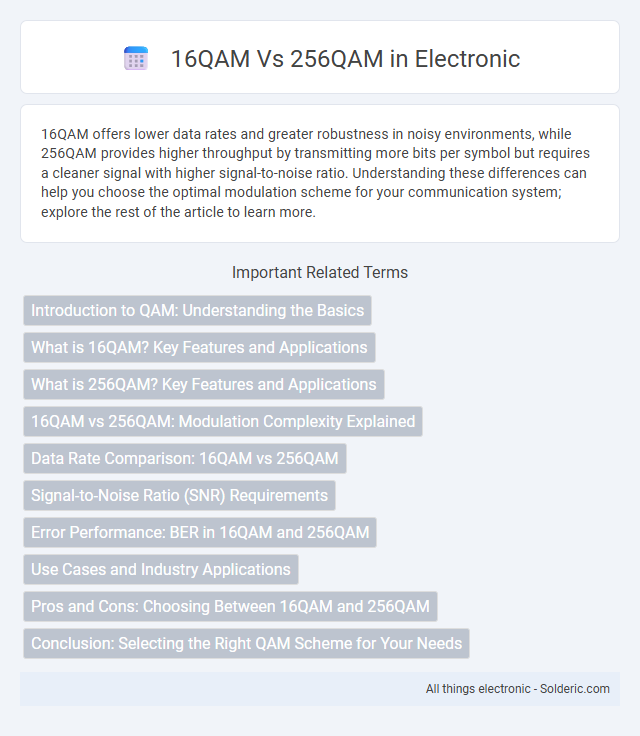16QAM offers lower data rates and greater robustness in noisy environments, while 256QAM provides higher throughput by transmitting more bits per symbol but requires a cleaner signal with higher signal-to-noise ratio. Understanding these differences can help you choose the optimal modulation scheme for your communication system; explore the rest of the article to learn more.
Comparison Table
| Parameter | 16QAM | 256QAM |
|---|---|---|
| Modulation Order | 16 symbols (4 bits per symbol) | 256 symbols (8 bits per symbol) |
| Data Rate | Lower | Higher |
| Bandwidth Efficiency | Moderate | High |
| Signal-to-Noise Ratio (SNR) Requirement | Lower (better performance in noisy channels) | Higher (requires clean channel) |
| Bit Error Rate (BER) | Lower BER at given SNR | Higher BER at same SNR |
| Use Cases | Robust transmission in noisy or mobile environments | High data throughput in stable, high SNR conditions |
| Implementation Complexity | Lower | Higher |
Introduction to QAM: Understanding the Basics
Quadrature Amplitude Modulation (QAM) combines amplitude and phase variations to encode data efficiently in digital communication systems. 16QAM uses 16 distinct symbols, allowing 4 bits per symbol, while 256QAM employs 256 symbols, enabling 8 bits per symbol and higher data rates. Your choice between 16QAM and 256QAM impacts bandwidth efficiency and signal quality, with 256QAM requiring a stronger signal-to-noise ratio for reliable performance.
What is 16QAM? Key Features and Applications
16QAM (16 Quadrature Amplitude Modulation) encodes data by modulating both amplitude and phase across 16 distinct constellation points, enabling transmission of 4 bits per symbol. Key features include moderate spectral efficiency, robust noise tolerance, and balanced complexity, making it suitable for wireless communications and digital TV broadcasting. Applications of 16QAM span Wi-Fi networks, LTE systems, and digital cable TV, where reliable data transfer with manageable bit error rates is critical.
What is 256QAM? Key Features and Applications
256QAM (256 Quadrature Amplitude Modulation) is a digital modulation technique that encodes data by varying both the amplitude and phase of a carrier signal, supporting 256 distinct symbol states. Key features of 256QAM include higher spectral efficiency and increased data rates compared to 16QAM, making it ideal for high-bandwidth applications like cable internet and 4G/5G wireless communications. You can leverage 256QAM in environments requiring robust data throughput and optimized network capacity, while 16QAM remains preferred for lower noise and simpler decoding needs.
16QAM vs 256QAM: Modulation Complexity Explained
16QAM and 256QAM differ significantly in modulation complexity due to their constellation size; 16QAM uses 16 symbols, providing lower bit rates and simpler decoding, whereas 256QAM employs 256 symbols, enabling higher data throughput but requiring more advanced signal processing and stronger signal-to-noise ratios. The increased symbol density in 256QAM enhances spectral efficiency but demands sophisticated error correction and precise amplitude and phase control to minimize symbol errors. Consequently, network systems implementing 256QAM must balance higher data capacity with increased complexity in modulation and demodulation algorithms compared to 16QAM.
Data Rate Comparison: 16QAM vs 256QAM
256QAM significantly increases data rates compared to 16QAM by encoding 8 bits per symbol versus 4 bits per symbol, effectively doubling the bit capacity within the same bandwidth. This higher-order modulation results in improved spectral efficiency, enabling more data transmission in wireless and cable communication systems. However, 256QAM requires a higher signal-to-noise ratio (SNR) to maintain error-free performance, making it more suitable for environments with strong signal quality.
Signal-to-Noise Ratio (SNR) Requirements
16QAM requires a significantly lower Signal-to-Noise Ratio (SNR) compared to 256QAM, making it more robust in environments with higher noise or interference. Typically, 16QAM operates effectively at an SNR around 12-18 dB, while 256QAM demands an SNR of approximately 24-30 dB for reliable data transmission. This higher SNR requirement for 256QAM enables greater data throughput but necessitates cleaner signal conditions for optimal performance.
Error Performance: BER in 16QAM and 256QAM
16QAM exhibits a lower Bit Error Rate (BER) compared to 256QAM at the same Signal-to-Noise Ratio (SNR) due to its simpler constellation with fewer symbol points, which reduces the probability of symbol misinterpretation in noisy channels. 256QAM, containing 256 symbols, transmits more bits per symbol but suffers from higher BER in low SNR environments because tightly packed constellation points increase susceptibility to noise. The error performance gap highlights the trade-off between spectral efficiency and robustness, with 16QAM preferred in poor channel conditions and 256QAM favored in high-SNR scenarios requiring higher data rates.
Use Cases and Industry Applications
16QAM is predominantly utilized in applications requiring moderate data rates and robust signal quality, such as digital TV broadcasting and basic wireless communication systems. 256QAM supports higher data throughput, making it ideal for high-speed broadband, advanced LTE networks, and fiber-optic communications, where maximizing bandwidth efficiency is crucial. Understanding your network's performance requirements helps determine the optimal modulation scheme between 16QAM and 256QAM for industry-specific implementations.
Pros and Cons: Choosing Between 16QAM and 256QAM
16QAM offers lower complexity and better noise tolerance, making it suitable for environments with weaker signal quality, though it provides lower data rates compared to 256QAM. 256QAM achieves higher spectral efficiency and increased throughput, ideal for high-capacity networks, but requires stronger signal strength and experiences greater sensitivity to noise and interference. Selecting between 16QAM and 256QAM depends on balancing data rate demands with channel conditions and equipment capabilities.
Conclusion: Selecting the Right QAM Scheme for Your Needs
Choosing between 16QAM and 256QAM depends on your priorities for data throughput and signal robustness. 256QAM provides higher spectral efficiency and faster data rates but requires a stronger signal quality and is more susceptible to noise, making it suitable for high-quality connections in stable environments. Your optimal QAM scheme balances speed and reliability based on network conditions and device capabilities.
16QAM vs 256QAM Infographic

 solderic.com
solderic.com